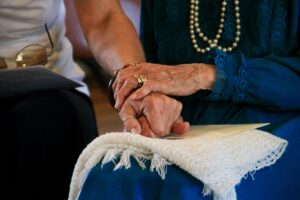
According to the World Health Organization, 15.7% of people over 60 are subject to elder abuse. This alarming and heartbreaking statistic can only be lowered if we educate ourselves on the signs of elder abuse, and learn how to stop it. No matter how uncomfortable it may be, everyone should know what to look out for.
Keep reading to learn elderly abuse facts and how to spot elder abuse.
What Is Elder Abuse?
There are seven generally agreed-upon forms of elder abuse that take place. Not only is it important to recognize what is considered elder abuse, but it’s also crucial to understand the different approaches necessary to handle each form. The seven types of elder abuse are:
- Emotional/psychological abuse
- Physical abuse
- Abandonment
- Financial abuse
- Sexual abuse
- Self-neglect
- Neglect
Every one of these types of elder abuse is extremely detrimental to an elder’s health and well-being. Not only can they cause emotional distress and suffering, but physical harm and death. For each of these types of abuse, there are specific signs and symptoms of elder abuse you should look out for.
Let’s go into each in a little more detail.
Emotional Abuse
Emotional abuse comes in a lot of different forms. It could be insults, name-calling, threats, or isolation to name just a few things. If a caregiver is withholding certain resources from the elderly person, this can also be considered emotional abuse.
Anything done to elicit a specific negative emotion out of the elderly person is emotional abuse.
An elderly person may be experiencing emotional abuse if they appear regularly scared, withdrawn, or tend to avoid eye contact. These signs will increase if they’re in the presence of their abuser. Their sleeping and eating patterns may suddenly change, along with their mood and their self-esteem.
Physical Abuse
Any act meant to physically harm an elderly person is considered physical abuse.
The signs of physical abuse towards elders are often visible, but sometimes are not. The most obvious things to look out for are cuts, bruises, broken bones, burns, and sprains. You’ll also want to look out for self-treated wounds, lost teeth or hair, and hidden signs of damage.
There are behavioral indicators of abuse. Many times an elderly person will try to hide their wounds, or forgo treatment for them out of embarrassment or fear. If the elderly person in question is refusing care, or has a nonsensical explanation for their wound, abuse may be the case.
Abandonment
Abandonment happens when a caregiver or family member abandons an elderly person without consent or prior preparation. They may drop them off to another family member, at a nursing home, or simply onto the streets as a way to forgo taking care of them.
If the elderly person in question is confused, lost, depressed, or malnourished they may have been abandoned. They also may have no home, may be frail, and may be lacking proper medication. Sometimes abandoned elders have dementia, meaning they may not know how they were abandoned.
Financial Abuse
Financial abuse is the most self-reported type of elder abuse, highlighting a big problem. Financial abuse happens when someone takes money or property from an elderly person without their consent.
Elder financial abuse laws vary by state, but there are some general signs you can look out for everywhere. One sign is property suddenly going missing, and the elderly person not understanding their financial situation. If you try to get money out of the ATM for the elderly person and it won’t come through, someone may be stealing their money.
You should also look out for unexpected eviction notices, unpaid bills, or canceled checks. If the elderly person has email or online accounts, check those out. Elders more often succumb to online scams as they may not be as tech-savvy as younger folks.
Sexual Abuse
Elder sexual abuse happens when someone performs unwanted sexual acts on a senior citizen.
There are a lot of key signs of elder sexual abuse, but some aren’t as visible as others. This is especially true if the elderly person has dementia or memory issues. They may not remember who abused them or be able to accurately describe the abuse.
Look for signs of bleeding in the genital areas. A victim of sexual abuse may have bruises around the breasts or legs, the buttocks, or have pelvic injuries. They may have trouble walking and sitting, or genital pain in general. Depression and emotional withdrawal are common here, and suicide attempts may even be present.
Self-Neglect
Self-neglect is often overlooked as a form of elder abuse, but it’s a very real and important one to keep in mind.
Elder self-neglect happens when an elderly person is unable or unwilling to look after their basic needs. This may be due to pain, Alzheimer’s or dementia, or limited mobility.
The signs of elder self-neglect include a lack of hygiene (unclean teeth, unbrushed hair, being unshowered, etc.) and lack of proper nutrition. The elderly person may be dehydrated, hungry, and thin. They may wear the same clothes all the time, have unusually messy living spaces, and neglect to pay bills or stock their fridge.
Neglect
Neglect happens when an in-home caretaker or nursing home caregiver does not take proper care of an elder.
Many of the signs of neglect are shared with those of self-neglect. A general lack of hygiene, medical care, and nutrition may be present. Their homes may be a mess, they may wear the same clothes all the time, and they may not do any activities outside the home or bed.
Neglect is one of the most common forms of elder abuse, making it crucial to know the signs.
What Can I Do to Stop Elder Abuse?
Abuse of an elderly person is a big problem, and it’s understandably a hard one to put a stop to.
The most important thing you can do to stop elder abuse is to pay attention to the warning signs of elder abuse and neglect. Learn them, and look out for them not only in your own family members, but in elders at large.
No matter who the person is—whether a co-worker, family member, or in-home caregiver—proving elder abuse and calling it out when you see it is important. Cut ties with abusers and report them to authorities. Taking action against elder abuse is the only effective way to lower that 15.7% of people over 60 reporting elder abuse to 0%.
If you need a trustworthy advocate or professional caregiver for your elderly family members, contact Stowell today.












